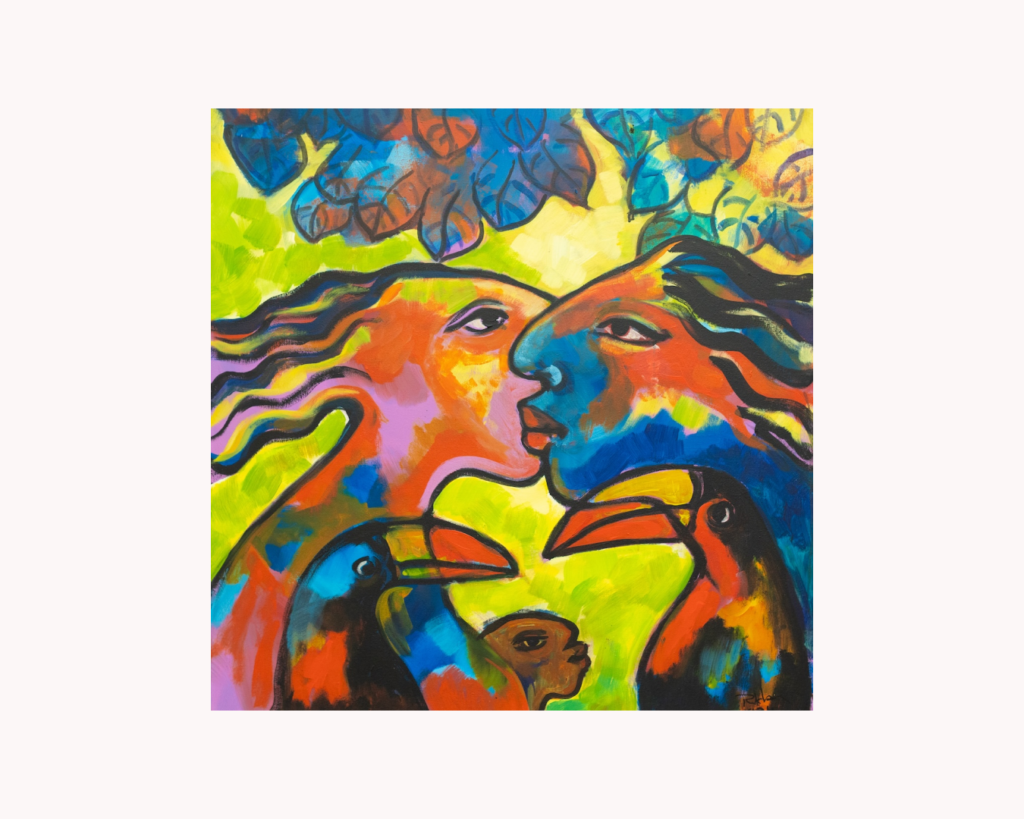Ma, you had something to tell me?
What I have to tell you?
I want to tell you I love you.
Come back to me my child
What is your work?
Where are you going?
Are you too going to the place of bright lights,
No birdsong no crickets
grey barren plains, no song, no Sun
Breathless empty eyes, running, rushing
All that glitters is not gold.
Why are you turning away?
I have to tell you
Come back to me my son
Let me tell you this
I have loved you from the beginning
Look up, look to the sky
Here the colibri whispers
The river knows your name
Where are you hiding?
Where are you running to ?
Take off your shoes come closer
Let me tell you this my girl
Trust the wind
The earth is soft, she is holding you tight.
She will show you the way
Come back to me my child
Come back to me
Come back home
Come back
As above, so below.
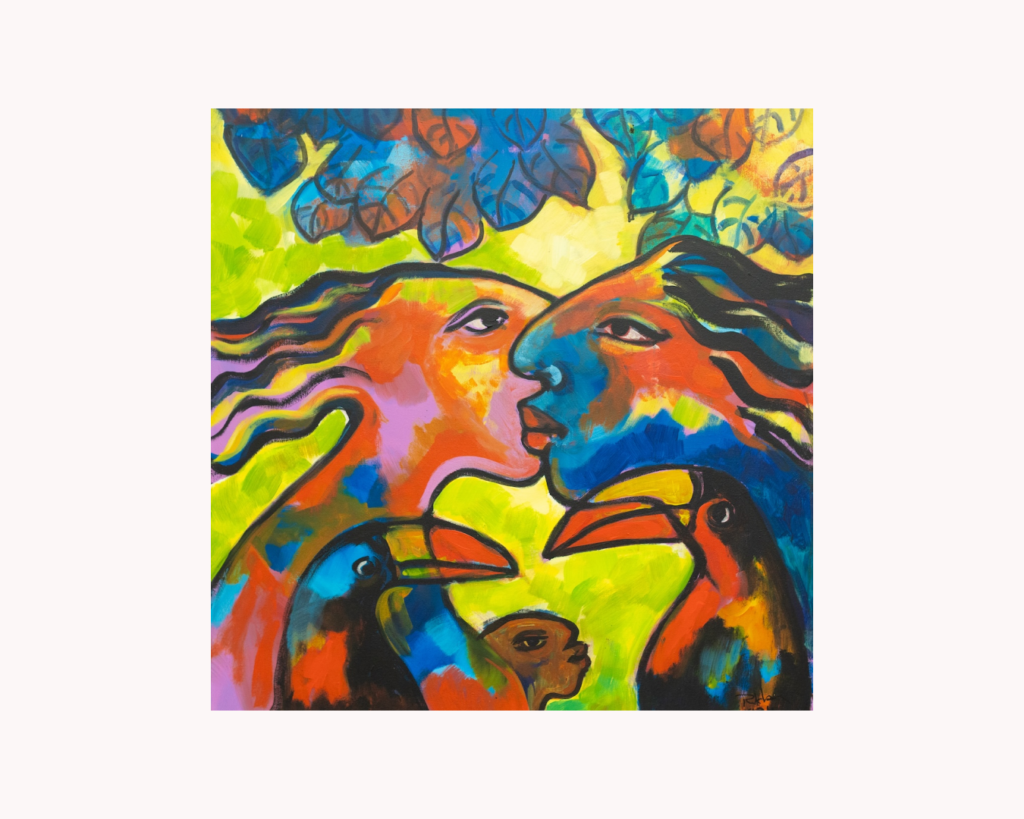
Wan tori de, 2024. Acrylic on canvas, 90 x 95.5 cm
Rinaldo Klas courtesy Readytex Art Gallery
In another time, in another space, as they continued to ponder the immensity of the skies above, the Amerindians, the First Peoples of the Caribbean would find a way to bring their sky closer.
The Maluwana or ciel de case (literally translated Eng. as the “sky of the home”) is an integral part of the Wayana tribe’s Amerindian art, civilisation and culture. In every Amerindian village, the Maluwana would be placed in the centre of the tukusipan or collective house. Made from a round, wooden disc of the Silk Cotton tree (ceiba petandura) or Guardian of the forests in Amerindian and Maroon cultures, within the Maluwana are drawings of animals, spirit creatures and natural elements, traditionally painted with natural clay. Also embedded in the Maluwana are elements of sacrality, protection, care, shamanic wisdom, respect for the natural world, community and the circular. This is a story of the interconnected cosmos: dancing and in perpetual movement.
In his new exhibition Whispers (2024, Readytex Art Gallery, Suriname) Rinaldo Klas presents a series of works which compel us to remember the ways of ancestral indigenous knowledge and the way we were. The way in which we built, the way we looked to the sky, to the forests and life cycles for guidance and for sustenance.
“Every Surinamese carries a part of the Amerindians in them”.
Rinaldo Klas, 2024
At the core of Klas’ work, there is a deep admiration for all sentient beings with whom we share the land. There is an understanding of the whole. We also read his unwavering commitment to Nature, Indigenous legacies of the Amerindians and his own Surinamese Maroon heritage: Klas’ mother was a Maroon, from the area of Moengo Suriname. “The Amerindians have been living in these forests since the beginning of time. The Maroons learnt from them when they escaped the plantations. Coupled with West African knowledge, together they lived as part of Nature and created their world…” Rinaldo Klas reflects.
What we lost in Empire
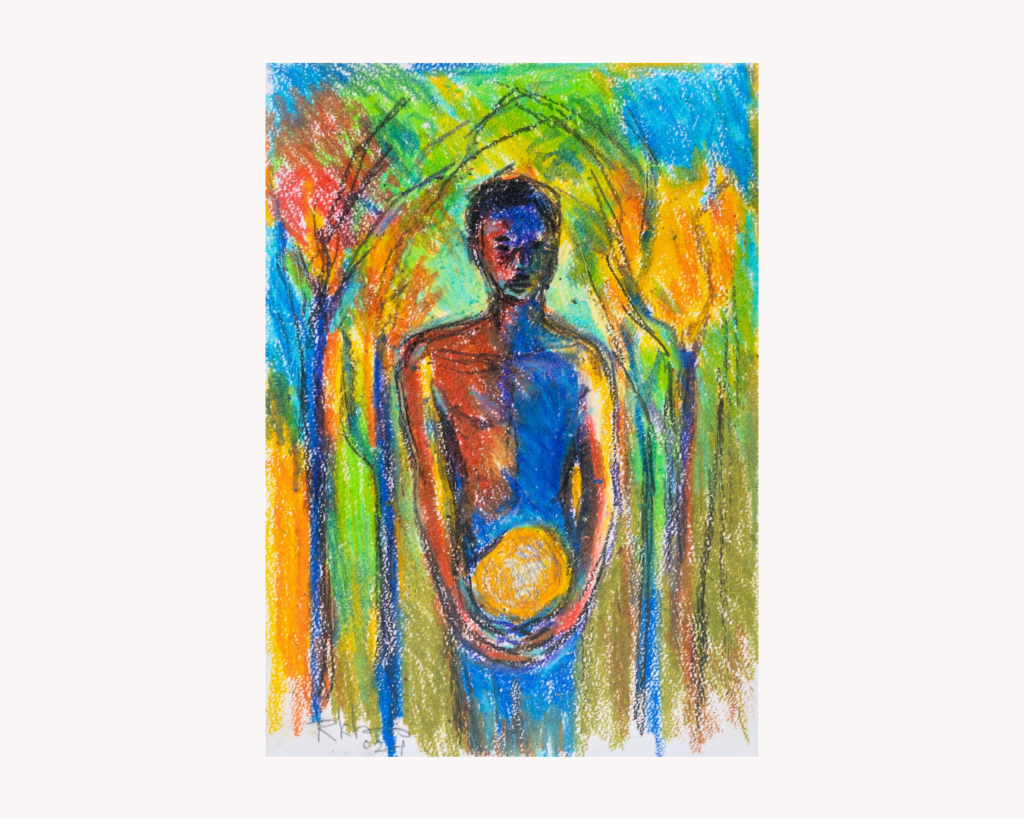
Gowtu (2024) Oil pastel on paper, 29.5 x 21cm
Rinaldo Klas courtesy Readytex Art Gallery
Nature is a part of us. We are a part of Nature. But the words have lost their meaning.
In her book Decolonial Daughter: Letters from a Black Woman to her European Son writer Lesley-Ann Brown has penned a chapter entitled: What we lost in Empire. This chapter details the destruction, erasure, loss and alienation from the Earth and our natural environment, which occurred with the advent of colonization in the Americas, the Caribbean and what we now understand as the Global South.
Progressively, as we distanced ourselves further and further from this Earth connection, there was an altered understanding of the human-Nature relationship as well as of interpersonal relationships. Over time, the needs of the individual superseded the needs of the collective, the natural environment was no longer seen as a home, essential to Life, but rather a means to an end, another resource to be consumed. We could get, extract, take, grab – without consideration for natural cycles, rhythms, balance or future sustainability.
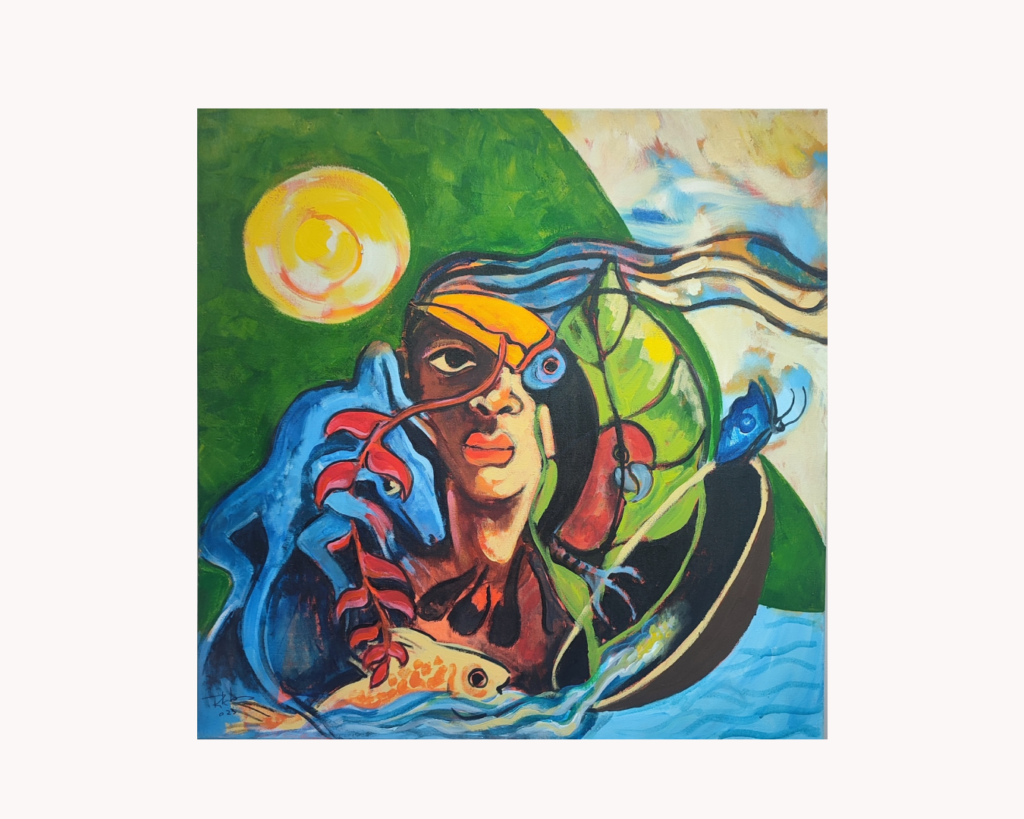
Gold and Environment (2024) Acrylic on canvas.
Rinaldo Klas courtesy Readytex Art Gallery
Works such as Gowtu (2024) and Gold and Environment (2024) remind us of Suriname’s long history of Gold mining, extraction and exploitation since the 1600’s which has now reached alarming proportions.
Economic capitalist ideals of acquiring more and more currency, in this case “the gold”, coupled with the desire to wield power …has led to a situation whereby there is an unprecedented exploitation, deforestation and destruction of interconnected ecosystems.
Extractive industries which dig deep into the Earth’s surface as well as the use of mercury are now poisoning rivers and water sources in the Amazonian jungle while simultaneously releasing harmful substances into the atmosphere. Ultimately this destroys natural flora and fauna, with disastrous effects on populations who live in these forested areas and beyond.
But when did we stop listening? Whose stories are we consuming? When did we forget that whatever we do to the Land, we are doing to ourselves?
The Messenger
Conscious of the ripple effects of environmental degradation since the era of Chico Mendes, Brazil (80’s – 90’s) deforestation and in Suriname “the Gold Rush”, Rinaldo Klas continues to position himself as a keen observer, a whistleblower, environmental justice advocate, activist and a doer.
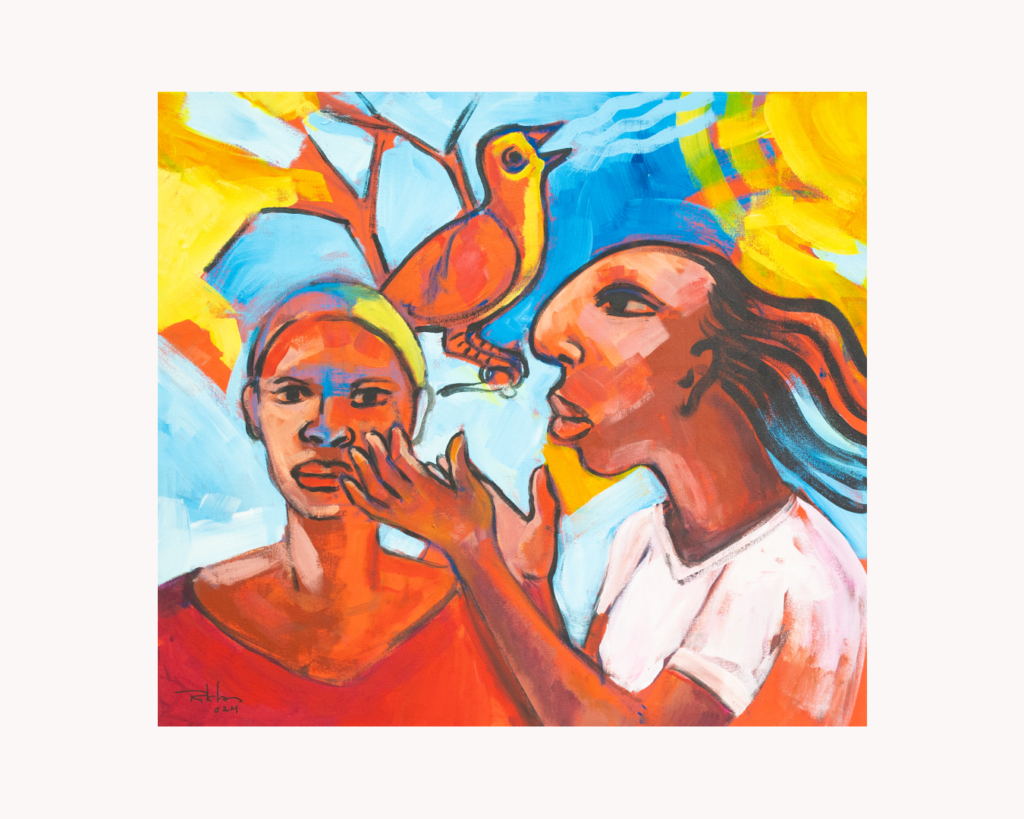
Wi SA singing a son opo (2024), Acrylic on canvas 100 x 90 cm.
Rinaldo Klas courtesy Readytex Art Gallery
“Art is a message. I will keep telling the story until everyone understands…If you see something with beauty, it is easy to understand…so I want to make sure that everybody understands.”
Colour, technique and language are an integral part of Klas’ message, which are all employed as tools for accessibility. Rinaldo Klas’ palette is vibrant, kaleidoscopic and engaging.
Gold spheres, tropical vegetation, animals such as frogs, fishes and the Powisi (Black Curassow; Crax Alector) commonly known in Suriname as “the gold eating bird” – reinforce the rich symbolism in Klas’ work. Recurring motifs such as the Amerindian spirit (Adorno type facial profile) reiterate the message of our genetic connection as modern day humans to the First peoples and ancient civilisations. In a subtle way, Rinaldo Klas also introduces the concept of intergenerational knowledge and wisdom handed down throughout generations, (existing concurrently with intergenerational trauma) and finally that there is much to be learnt by looking back to our History and histories, to understand and move forward (Principle of Sankofa: originating from the Akan people of Ghana, West Africa).
There is also a consistent and artistic decision when Klas blurs the lines of anatomical and organic forms in his paintings. Almost indissociable, human figures become beaks, becoming feathers, becoming protective arms, becoming roots…the natural, human and spiritual worlds ebb and flow into each other. Seamlessly and endlessly.
Finding our feet again
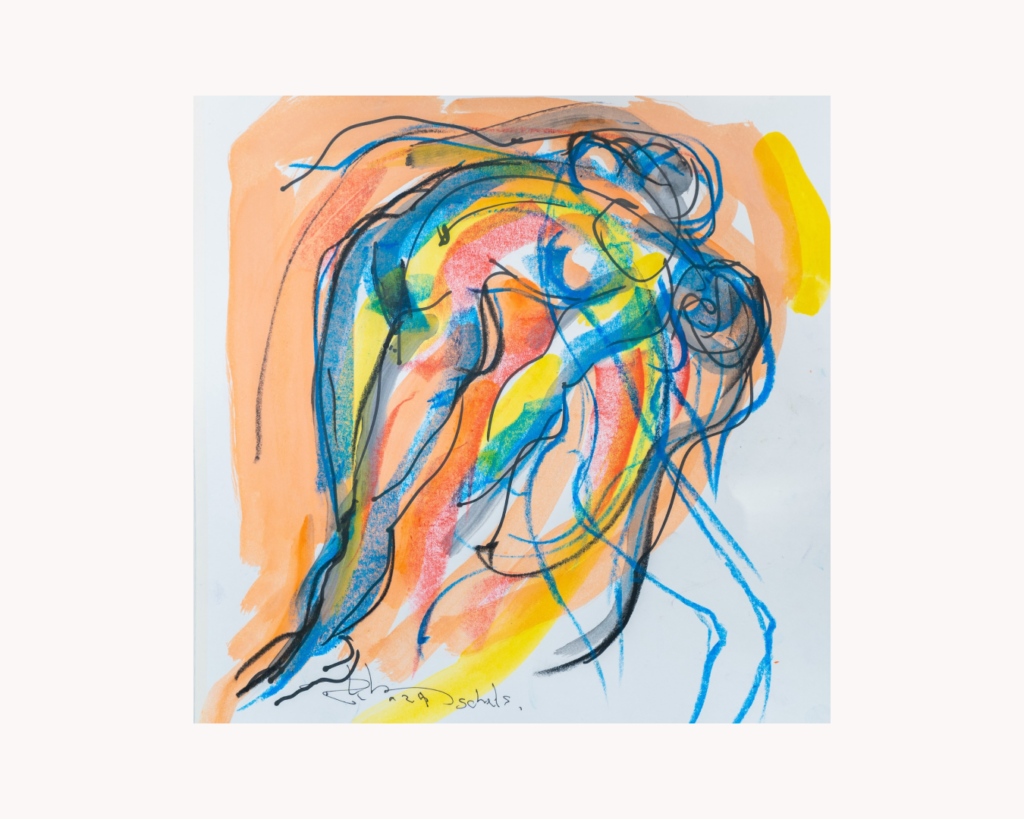
In Beweging 3 / In movement 3 (2024) Mixed media on paper, 34 x 34 cm.
Rinaldo Klas courtesy Readytex Art Gallery, Suriname
Rinaldo Klas explains: “All these shoes… our feet have gotten weak. We don’t even have a connection with the earth anymore.” In fact, in our quest for modernity, development, progress, – as humans, Klas asserts that we have lost our grounding and we have stopped listening to our intuition. We roam oblivious to the earth’s energy and our innate connection as human beings to the earth’s magnetic force.
Connection therefore or rather re-connection, means taking off all these shoes, shedding the layers, getting closer to the natural world, to truly listen, feel and touch. Klas tells us to come closer, where we adopt a decolonial posture of coexistence with the environment instead of dominating it. Softer, gentler, quieter.
“Nature is telling us so much, but we are not listening.
Her voice is soft, subtle so you have to listen carefully…”
Rinaldo Klas
By listening to and getting closer to our natural environment, we are acknowledging our connection to something greater than ourselves. Paying attention to the whispering of Mother Nature, silently, one by one we recognize that individual consciousness is the beginning of our collective healing and transformation.
The way Home.
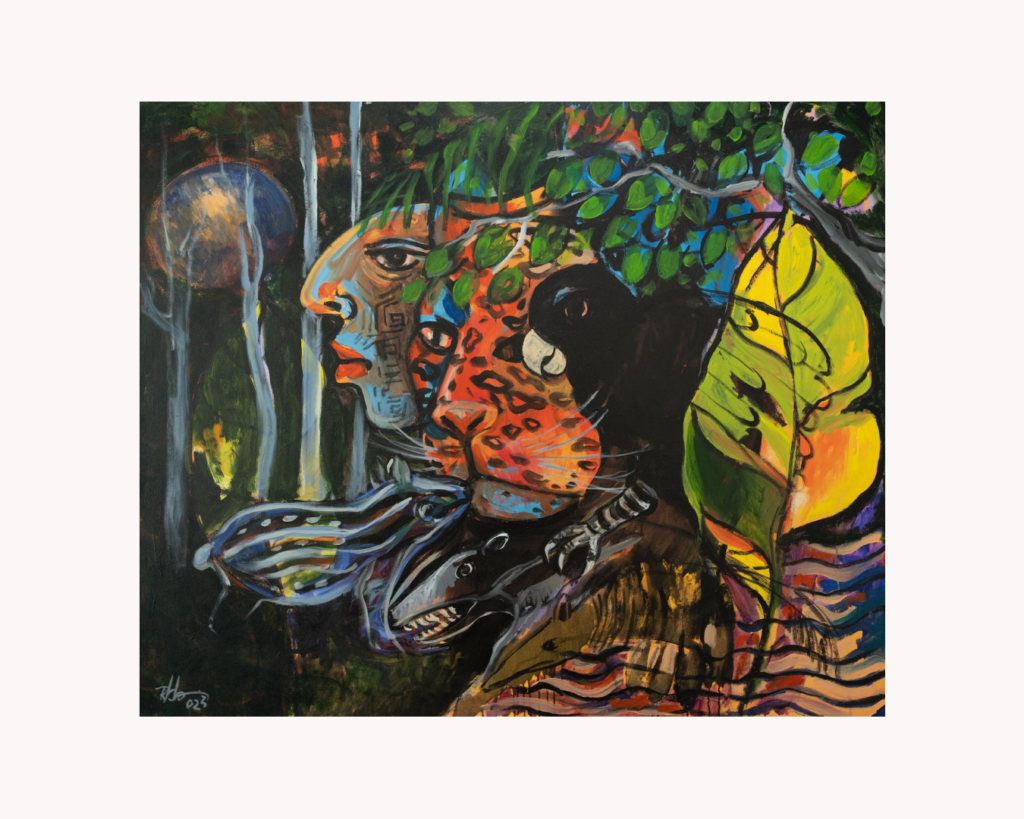
In the jungle (2023) Acrylic on canvas, 140 x 130 cm
Rinaldo Klas courtesy Readytex Art Gallery, Suriname
“Finding home is not just about a place, but about understanding and healing the ruptures within ourselves and our histories.”
Lesley-Ann Brown
In her essay Malaise d’une civilisation (The Malaise of a Civilisation, 1942) Martinican intellectual, theorist and writer Suzanne Cesaire, elucidates her post-humanist theory and anthropological concept of l’Homme Plante (The Plant Man/ Plant Human). According to this concept, the Martinican is profoundly rooted in his environment, and lives in harmony with the rhythm of universal life. Cesaire’s post-humanist theory presents itself in sharp contrast to Western linearity of unabated performance, production and control of resources.
Beyond Humanism, Suzanne Cesaire explains that l’Homme Plante, the Martinican – and within a broader Caribbean postcolonial context – embraces and “trusts in the continuity of the life cycle: from seedling, to growth, to blossoming to maturity, then the cycle begins again. It is poetry experienced and felt deeply.” (pg. 33). The writer uses this metaphor to illustrate the resilience and adaptability of the human spirit, comparing our own capacity to adapt and survive to that of the natural world.
Through the lens of Post Humanism therefore, the Plant-man/ plant-human surpasses the limitations imposed by an exploitative society by precisely transforming and becoming more than human…
The current work of Rinaldo Klas in the exhibition Whispers invites us to do just this, and his painting In the Jungle (2023) particularly so. In this piece, Klas urges us to remember that the forests and jungle are our biggest library of medicine, the natural cycles and patterns present in our environment and ecologies all have meaning.
By moving away from neo-colonial modes of being and doing based on extraction, immediacy, inequity and overconsumption, Klas demonstrates that it is possible to transform. To grow. To blossom.
It is an individual and collective remembering of who and of that which we are a part, whereby we restore our connection to the Mother Spirit present in Indigenous cosmologies, Nature’s elements and all creatures, to an ethos of care and collective well-being.
This time, as we look to the skies, if we listen closely we will find home.

Rinaldo Klas (B. 1954, Suriname) is a visual artist whose work reflects his deep concern for nature and the environment. Educated in Suriname at the ‘Nieuwe School voor Beeldende Kunsten’ and subsequently in Jamaica at the Edna Manley College of the Visual and Performing Arts, Klas has further enriched his practice with exhibitions, knowledge sharing and residencies in Jamaica, Venezuela, Brasil, the Netherlands, China, the USA, and French Guiana. Rinaldo Klas considers it his responsibility as an artist and a human being, to convey an important social message to the rest of the world.
Courtesy Readytex Art Gallery
